Did Somebody Say...Clay? Paloma Proudfoot at Fondazione Bonollo
A new foundation brings contemporary art to the countryside. And Paloma Proudfoot (Millennial, British) bridges the gap between the past and the present.
An unconventional approach
Paloma works with ceramics in a way that I’d almost call counterintuitive. Ceramics are a very moldable material, inviting depth and shaping. My mind goes to vessels first (that’s also the direction of Paloma’s early works). Paloma, instead, flattens her ceramic pieces and shapes them only lightly. Here and there, a clothing fold or a slightly protruding nose as if it were a wall relief. A body is made up of many separate pieces held together only by golden metallic bolts, like islands pinned to a map. Those bolts remind me of old plaster sculptures held together by metal pins, which oxidised and turned black over the centuries.
Paloma does have series where bodies are more gender ambiguous (for example, her works at the Unruly Bodies group show), but here, her protagonists are young women. The bright color palette and pronounced outlines on otherwise flat pieces make me think of soothing and playful styles of graphic novels.
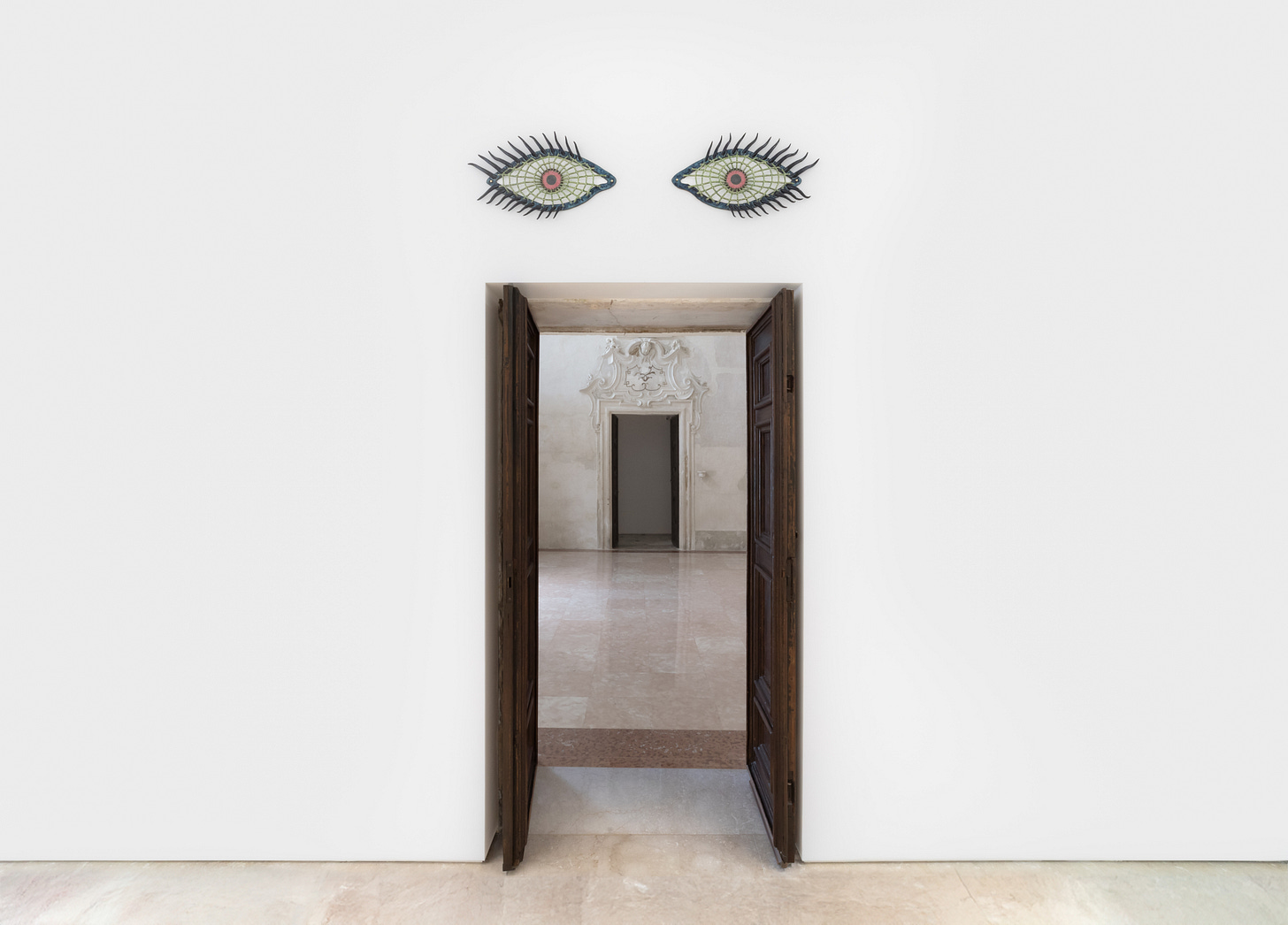
Playing (by) the rules
The exhibition's main work is Speech Weavers (2025), a 2.5-meter-tall ceramic piece on linen installed on the altar of the baroque chapel Chiesa della Concezione di Maria Vergine, which is part of the foundation space. Stefano Bonollo told me that the female Dimesse order originally used the chapel. They’d follow the sermon through the sound extension in the upper walls, separate from and not actively participating in the service. Speech Weavers engages with the space’s history: Instead of the Christian Holy Trinity, three contemporary women take up the linen fabric. The Cross is replaced by a green wall that isolates every woman. Speakers connect them, and while two women listen, one speaks to them via a cord phone, breaking the cycle of silence.
Unfortunately, the idea feels rather banal. Church = Patriarchy = Silent Women; Speaking Women = Disruption. Although true in many instances, it is a rather limited viewpoint on the church’s institutional history and doesn’t do justice to the complex roles of women in Christian theology. Sure, it connects kinda to the history of this place, but if you really wanted to, you could have dug a bit deeper. This instead feels like the flat messaging of mid-2010s corporate “speak your truth, girlypop!” messaging.
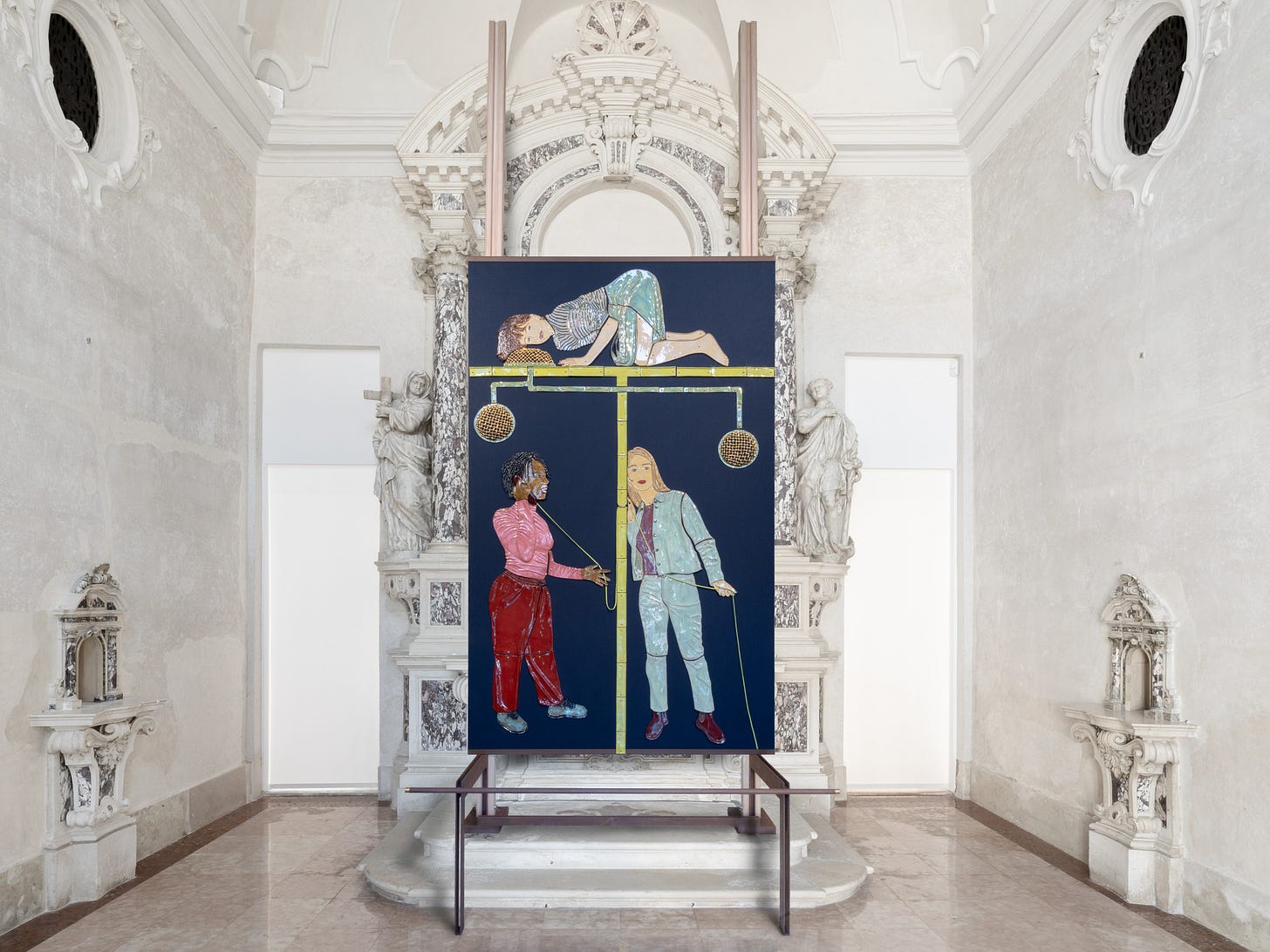
Paloma breaks out of the flatness with unusual details. I’m less interested in the 3D phone and speakers and more in the flat hands, which she still manages to physically wrap around the fabric cords and the phone. In other works, too, she adds shape to eyelashes, a collar, a sleeve, a nose, or a hand holding a flat umbrella in the background.
When Body Isn’t Tea — It’s Mystery
Speaking of hands, they often appear chopped and floating as separate entities. A lighthearted, surreal moment is a wooden-looking mannequin hand pulling back a curtain. A foreign hand smudges lipstick on another woman’s bare back in Everybody has their own view (2024). This in turn is very churchy, because in Christian iconography, the hand spawning out of nowhere is the Hand of God or Manus Dei.
A manicured floating hand pulls a thread in Threaded II (2024): Paloma ripped apart a human’s back. The spine, nervous system, and ribs are fully exposed. There’s no blood, only a green garment peeled back and unzipped to the very heart-shaped bottom. A disembodied hand with dark nails mimicking the nerves’ color pulls one out of its place, holding it between two fingers with seemingly no intention — excuse the pun — but to get on their nerves. Paloma made clay look like organs, which in turn look like textile threads.
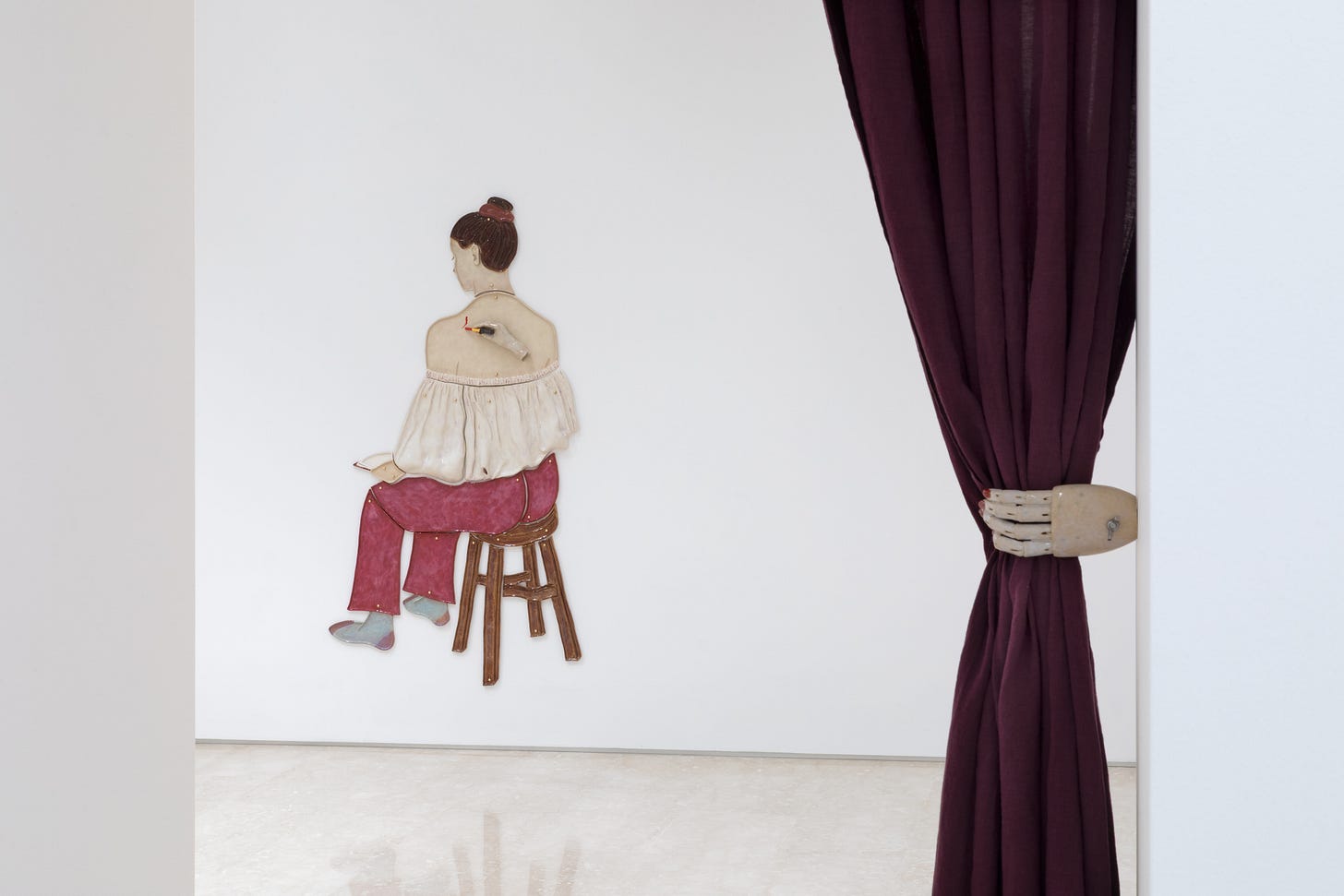
Paloma draws connections to how the human body repeats the patterns of nature. A couple of days ago, I was at the beach looking at the many shells lying around at the shore, and it struck me how closely their lines resemble the structure of fingernails. I wondered how that young man who dreamed of becoming a priest almost 200 years ago felt when he discovered that the world was different from what he believed his whole life...
She makes the blood vessels in a pair of eyes mimic the intricate structure of spiderwebs. Bronze tree branches grow out of hand-shaped fleshy red ceramic moulds in Title tbc (Bronze branch hands) (2025), naturally following the slightly curved shape of the fingers. A Rosana Paulino (Gen X, Brazilian) combo would be elite. The nerves in the hands resemble the structure of the branches and … Wait. I just realized: Isn’t it strange how we call the inner surface of a hand palm? Brian looked it up, and turns out that the palm of your hand and the palm tree share the same word root.
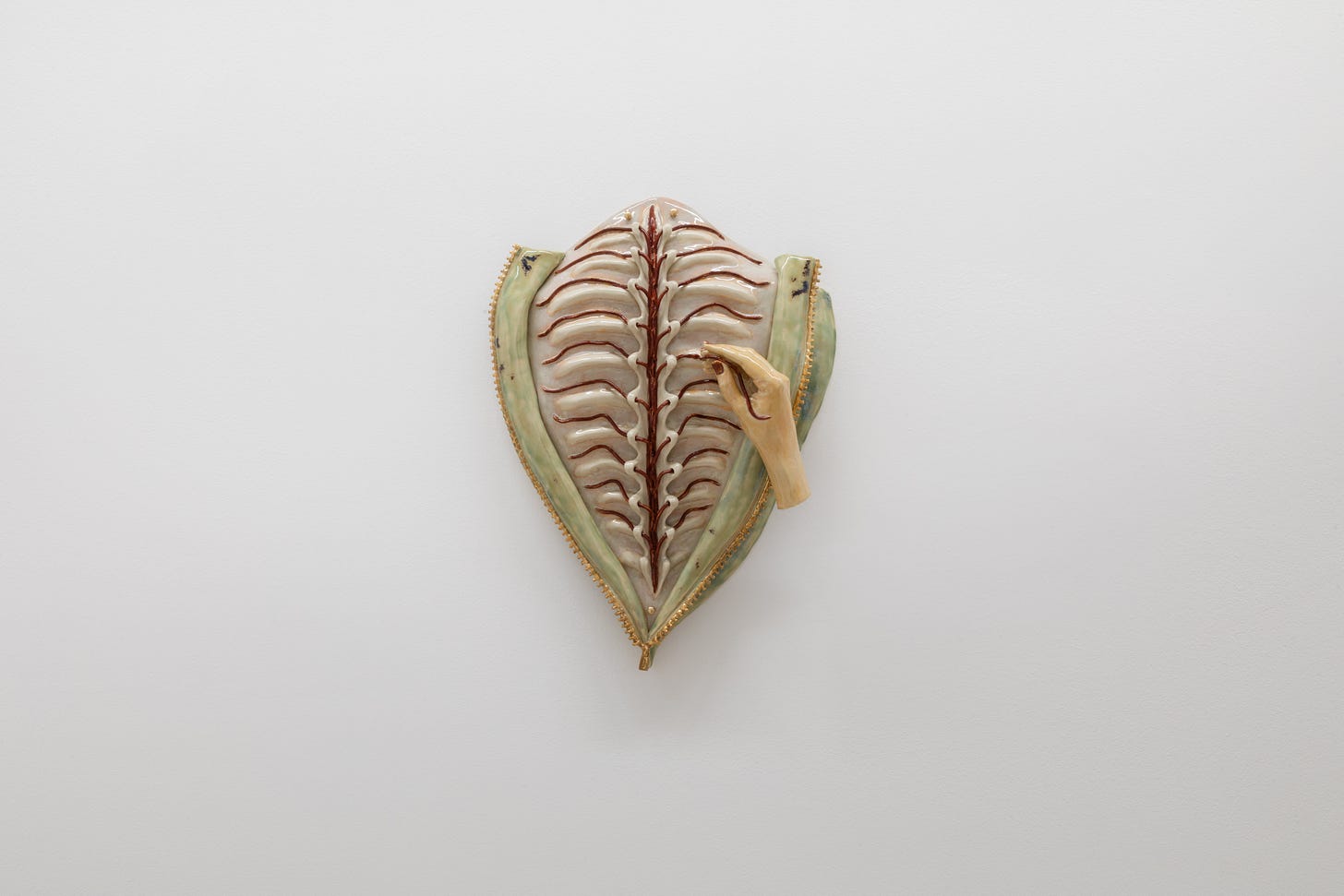
The ties humans and plants share are not only biological and linguistic but also mythological. Do you know the story of Apollo and Daphne? The sun god harasses poor Daphne and runs after her. Scared and with no other way out, she pleads with her father, Peneus, to change her form to escape Apollo, turning into a laurel tree. That fuck ass Apollo obviously didn’t get the clue that she wasn’t interested, and went on to pluck her laurel leafs to make himself the wreath that became the symbol of victory… Gian Lorenzo Bernini probably made the most famous version of that story, capturing the moment Daphne’s hands turn into leaves.
Combining ceramics with mythology makes sense. Clay is part of many creation myths. Adam was made out of earth; the word human comes from humus (not the food), which means “earth,” just the way Adam’s name comes from the Hebrew word adamah (earth). In the Babylonian creation myth Enūma Eliš, the first humans were made from the blood of a god and clay. The Egyptian god Khnum formed the first humans from clay on a potter’s wheel. In the Mayan Popol Vuh myth, the Gods tried making a first version of humans out of mud. In some Chinese creation myths, it was clay, too, and the Yoruba deity Ọbàtálá created the first humans out of clay. An inexhaustible list, really.
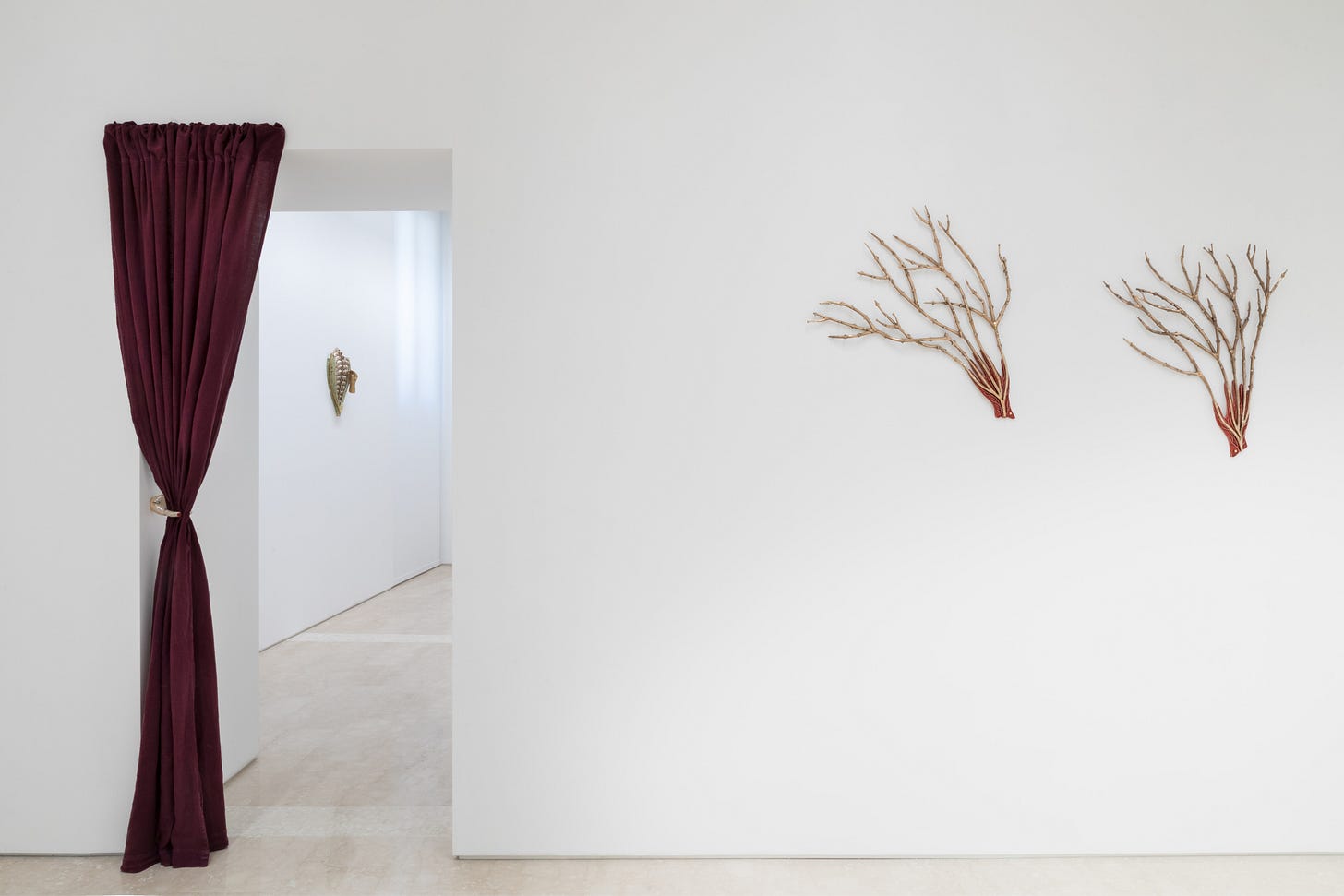
I enjoy the way Paloma connects the abstract concepts of feelings and myths to rather rationally coded anatomy and its evolution: Our experiences are tied to our bodies, but our bodies are connected to far more than just ourselves. Thematically, I would have preferred to focus on material and pattern repetitions in Paloma’s more mythical works. It would have fit the space better. Although pretty, her The Archivist (2025) series didn’t do it for me in the context of the show: It’s portraits of women archivists with which she attempts to shed light on their personalities beyond their profession. That feels like an entirely different question which deserves its own time and place.
The exhibition offers an overview of Paloma’s themes and recurring concepts. And if you think of this show first and foremost as an overview and introduction for the quiet town of Thiene, then yes, that’s fine.
Paloma Proudfoot: Speech Weavers, until August 30, 2025, at Fondazione Bonollo, Thiene.
Fondazione Sandra e Giancarlo Bonollo
Via dell’Eva 1
Thiene 36016 (VI) Vicenza
Website
Instagram: @fondazionebonollo @palomaproudfoot
If you’re in Venice, I hope you’ll take the time to pass by the Foundation, it’s just right outside of Vicenza. Let me know what you think of this one!
See you soon!!!
Jennifer
The Gen Z Art Critic




